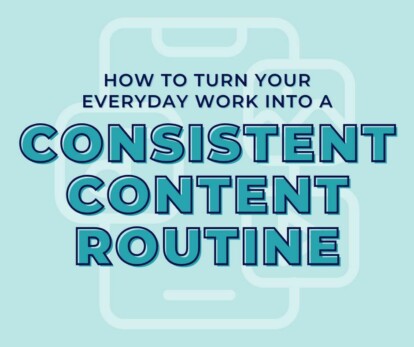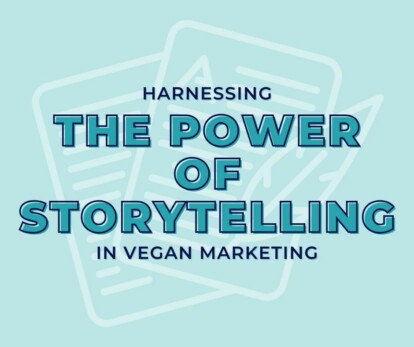How to turn your everyday work into a consistent content routine


As a long-living and complex species, storytelling matters to humans. It’s how we pass down our knowledge, wisdom, warnings, social rules, and experiences.
Stories keep people alive. They help raise new generations. They ensure that lessons are passed on so that (in theory, at least!) we don’t keep repeating the same mistakes.
Since we discovered fire, if not before, humans have come together to share stories. They help us know we’re not alone and let us venture beyond ourselves. Storytelling is hard-wired into our DNA.
This appetite for stories is one of the most powerful ways to connect with your audience and supercharge your vegan marketing.
The ultimate goal for any business is to create repeat customers who love what the business does enough to recommend it to other people. (In mission-led organisations, this might translate to finding people who will passionately support a cause and make others aware of it).
To achieve this, it’s vital to make a connection.
People need to feel like a business meets their needs or reflects their values, that it cares about them, and that they matter beyond the first purchase.
One of the ways to create this sense of connection is take them on a journey that requires emotional investment – something that can be achieved with storytelling. As we saw in the introduction, humans have always been captivated by stories, and when it’s used in marketing, it can propel a brand’s identity, impact, and reach.
Stories have the unique ability to transcend transactional relationships. Tell the right story to the right audience and it can capture their interest in a way that feels lasting and meaningful, rather than a soulless exchange in the marketplace.
This is especially relevant for vegan businesses because you want to engage people who are shopping on principles rather than price.
Using storytelling as a marketing tool can help you to:
Every story is a series of events. It’s the job of the narrative to take the audience through these events from a particular point of view. The aim is to build a tale that typically has a clear beginning, middle, and end.
When you use storytelling within your marketing, you’ll need to pinpoint your brand’s core narrative. What are the messages that you want to share? Why do they resonate with your audience? How can you build a story that evokes compassion or inspires action? What is the perspective?
If we use the For Charlie campaign as an example, the core narrative is that the RSPCA Assured Scheme facilitates widespread suffering for tens of thousands of farmed animals. The campaign powerfully demonstrates this through the real-life story of Charlie, a pig rescued from horrific conditions. The campaign’s main video brings the viewer along on the rescue and makes you root for Charlie to live.
Throughout the video we hear from a former RSPCA board member and a former RSPCA vet, a reminder that the story is authentic and told by people who have seen the truth.
Today’s audiences are cynical. We’re surrounded by stories, so it’s vitally important to use storytelling within your business in a way that feels honest. The For Charlie campaign uses real video footage and interviews to achieve this.
What would work for your business?
To resonate deeply with your audience, try to tell stories that foster a personal connection. You could do this by sharing the story of how your businesses started, your quest to source an ethical supplier, or how your brand makes a positive difference to a specific community. Alternatively, you could highlight customer experiences that show the impact your brand has had on their lives.
You could tell stories from within your business – for example, what a typical day looks like – or even ask your staff to talk about their favourite products or share something customers might not know about them, such as their claim to fame or favourite party trick.
These narratives not only humanise your brand but also build trust and loyalty. The hope is people will hear your story and want it to become part of their own.
Another approach is to use an analogy to tell a story. For example, you could compare the journey of adopting a plant-based lifestyle to planting a seed and watching it grow into a thriving plan. Just as a seed needs careful nurturing, sunlight, and water to grow, a vegan lifestyle requires care, attention, and the right resources to flourish – this could be the story you tell about a previous customer.
As mentioned above, you need to share the right stories for your audience. To do this, you’ll need to identify the problems that your audiences face and then position your vegan products or services as the solution.
Stories with emotion-driven narratives tend to leave the most lasting impact. People love seeing transformations, as we saw with Charlie’s journey from living without hope in a factory farm to her joy at playing in the fields of her new home.
Once you have a strong story to share, you’ll need to decide on its “hook” – the opening that’s going to draw readers in and make them curious about what happens next.
You could create a sense of suspense, for example, weaving an element of mystery or anticipation – or of peril (e.g. the risk of your business failing in its early days) – into the narrative can be a powerful way to grab audience attention. You could begin with a challenging scenario or problem that needs solving and gradually reveal how your vegan products or services provide the solution.
Another option is to do something unexpected. Could you flip the narrative or highlight an unconventional aspect of your business? For example, maybe you’ve developed a manufacturing process that is environmentally friendly and breaks from industry norms. You could tell the story of how that happened.
Or did your business start in an unexpected way? Look how Purple Carrot tells us that its story began with Netflix and a boring evening in 2013.
As already mentioned, emotional storytelling is among the most compelling ways to connect with your audience. By sharing stories that evoke emotions such as compassion, joy, or hope, you can invite your audience into an experience that goes beyond an exchange of goods and money.
The principle of “show, don’t tell” is critical in effective storytelling. Instead of just stating facts and delivering the result, you need to use vivid descriptions, visuals, and real-life examples to illustrate your points.
For instance, rather than saying a product is eco-friendly, you might show the impact it has on the environment through before-and-after scenarios or through the stories of those for whom it has made a difference.
This approach allows your audience to experience the story and draw their own conclusions, making the narrative more powerful and memorable.
Studies have shown that the human brain processes images 60,000 times faster than text and that visuals can improve learning by 400%! Maybe that’s why the first physical evidence of early stories is a series of cave paintings dating back 36,000 years.
To give your business stories more impact, it’s a good idea to include images, infographics, and videos to amplify the message of the narrative. Just remember to keep the visual elements consistent across all the platforms you use, so that people understand all the stories are connected.
Consumers are often worried about buying from the wrong company or regretting their purchase or involvement. This is why social proof is so important, i.e. evidence that other people have already made the purchase, and it’s improved their lives in some way.
One way to harness social proof is to involve your audience in the story of your business. You could do this by sharing their testimonials, asking them to create social media posts about your business (for example, a live unboxing of a product), or highlighting how your business has positively shaped their personal journey.
Interactive storytelling elements such as quizzes, polls, or live streaming can encourage audiences to engage with your narrative in real time.
It’s crucial to maintain a high level of ethical responsibility in your storytelling, especially because you’re operating in a sector that’s defined by its ethical stance.
This means ensuring that your messaging is honest and transparent, avoiding any manipulative or misleading narratives that could compromise the trust of your audience.
Being ethical in your storytelling not only aligns with the core principles of veganism – respect for our fellow animals, the environment, and human health – but also fosters a genuine connection with consumers who share these values.
It’s essential to align your brand story with the foundational values of veganism. Your narrative should consistently reflect the commitment to animal freedom, sustainability, and health that defines the vegan movement. By doing so, you not only promote your products but also contribute to the larger cause of advocating for a kinder, healthier, and fairer world.
As with all your marketing activities, it’s important to track the effectiveness of your storytelling campaigns. You can look at your social media insights, Google Analytics, and customer surveys to do this.
The answers to these questions should help you build a clearer picture about how to use storytelling in your business in the future.
Storytelling is a potent tool for connection that harnesses our deep-rooted instincts to share our experiences with others.
Whether you choose to tell text-based stories or share engaging videos, the right narrative could be central to helping you grow your business and mission. Start experimenting with your narratives today and watch as your audience becomes more emotionally invested in your success.